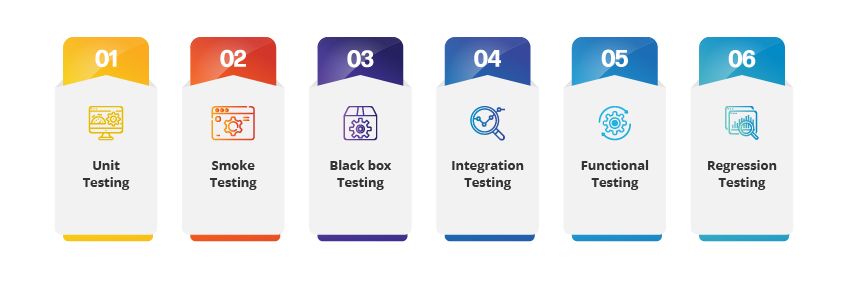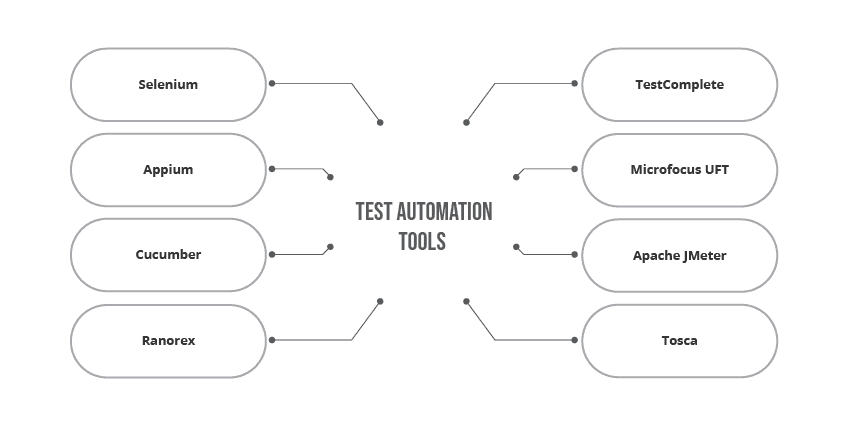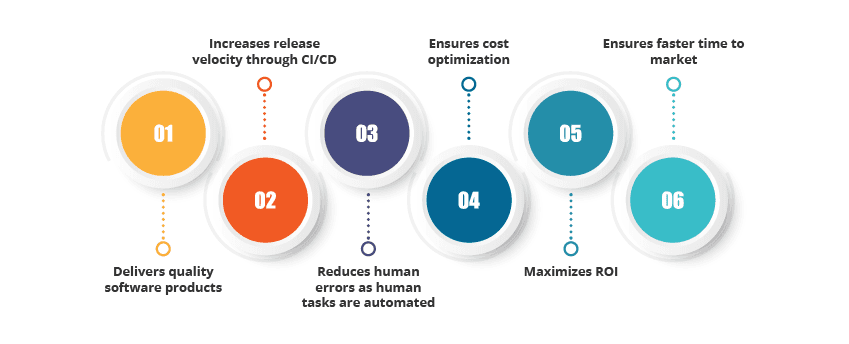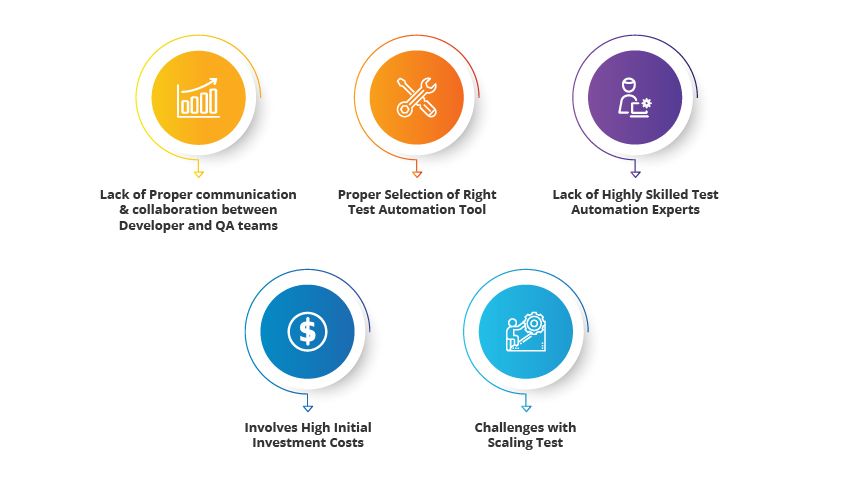
Enterprises across industries continue to demand faster releases and quality software to withstand the ever-changing market scenario and competition.
With enterprises following DevOps and agile methodologies of software development, software testing forms an integral part of it. The earlier manual method of testing does not suffice the present-day connected devices and complicated architecture applications with industry 4.0 in place.
Contents
- What is Automation Testing?
- What does Test Automation Do?
- Significance of Automation in Testing for Enterprises?
- Best practices of Test Automation
- Benefits of Automation Testing
- How does Test Automation works?
- What Does an Automation Tester Do?
- What are Automation testing challenges and how to overcome them?
- Automation Testing Vs Unit Testing
- Why Should You Leverage Next-gen Testing Services Provider for Test Automation?
- Related Queries on Automation Testing
There is a need for businesses to adopt test automation that ensures faster and quality releases along with saving considerable time, and efforts.
What is Automation Testing?
According to WIKI, automation testing is the use of software separate from the software being tested to control the execution of tests and the comparison of actual outcomes with expected outcomes.
Test automation can automate some repetitive but necessary tasks in a formalized testing process already in place, or perform additional testing that might be difficult to do manually.

Test automation can speed up the release cycles, increase coverage and ensures quality software releases.
In manual testing, a human is involved to perform the manual tests that are more prone to human error and might even lack their correctness. This sort of human involved testing encloses many gaps which are seen and sometimes even have missed project timelines due to the huge number of misidentified bugs.
But, as automation testing involves the usage of tools and test scripts to test the software, the results are more reliable and delivers accurate results while testing various use cases and user scenarios.
Hence, this sort of automation testing ensures effective outcomes and can be successfully used by businesses to ensure faster and quality releases.
Automated testing is also known as test automation is a method in software testing that effectively makes use of special test automation tools. These tools are used to control the execution of tests using well-crafted test cases for each of the user scenarios and compares the actual test results to the predicted or the expected results.
It is actually a process that validates if the software is functioning appropriately and meeting the given requirements using these test automation tools.
What does Test Automation Do?
Automation testing meaning can be broadly defined as the process which involves running scripts that are executed by leveraging software testing tools. Automated test systems ensure high accuracy and reliability of the test results.
As no human observations are involved, it ensures more accurate test results. Moreover, this sort of automation testing using open source and paid test automation tools is most suitable for regression testing, performance testing, load testing, security testing along with other types of testing.
Significance of Automation in Testing for Enterprises?

Software testing is essentially an important part of the software development life cycle (SDLC) and should be taken up to ensure quality software.
Earlier manual testing was the major mode of testing but with advanced applications and connected devices in place, it is essential to have Test Automation to ensure faster and quality releases.
Even smaller and mid-sized companies in their quest to have good quality products continue to adopt test automation best practices to deliver high-performing products to their clients.
For enterprises, with automation in testing in place, there is a faster feedback cycle and that brings faster validation at various phases in product development.
The other benefit of automation testing is the testing procedure becomes automated as the test scripts are run by the test automation tools without much interference of QA.
Test automation also helps enterprises to improve the communication between DevOps, QA teams and product owners who depend on the results of these automated tests as these results are more reliable than the manual testing results.
It is more important to note that automation testing is best suitable for applications that need to be tested for various versions, platforms, and operating systems.
Test automation involves the usage of tests that are repeatable and can be run many times to test various conditions and scenarios.
It is best suited with regression tests and high-risk functionality tests to check whether they fail under real-time conditions.
These automated test results help to save businesses of any probable loss due to their application failure as with effective automated software testing the results are more reliable.
Best practices of Test Automation
Below listed are 6 best practices for test automation:
1. Select the right automation tool:
Testing teams must select the right automation testing tool that is in-line with their project requirements which helps them to execute automated test cases in an effective manner.
2. Design tests before automating them:
It’s always preferred and is considered as a good practice to create test cases before initiating the test automation process. A good test design will eventually help in finding defects and fixing them.
3. Don’t plan to automate unstable functionality:
Whenever there is a new feature or functionality that is to be tested, care should be taken such that automation testing will be taken up only for stable functionalities.
4. Decide which tests to automate:
Every feature cannot be automated as there are certain features that require manual testing. A proper automation test strategy needs to be put in place to fulfil all those test cases that need to be automated.
5. Early and frequent testing:
To leverage test automation, it is much better to start testing early on in the software development process. By running automated tests often, testers will be in a better position to detect bugs and resolve them at the earliest. This would save time and money which would have been spent otherwise on fixing bugs at a later stage of the software development process.
6. Do not completely rely on UI test automation:
Completely relying on UI test automation is not considered as a best practice as every application might have some UI changes made. Hence, UI testing should be planned carefully to ensure the app delivers a great user experience to end-users.
Benefits of Automation Testing

There are many benefits with Test Automation which have been broadly classified as Qualitative and Quantitative benefits.
Qualitative Benefits of Automation in Testing
– Speeds up the testing cycle with automated runs
– Reduces test execution time effectively
– Increases test coverage on each testing cycle
– Ensures ease of test case maintenance
– Reduces the need to update scripts in case of changes to the application
– Ensures faster test scripts generation
– Facilitates reusability of code
– Reduces manual intervention and they can be utilized for functional testing
– Reduces testing timelines significantly
– Reduces regression testing time enormously
– Saves time as automated testing brings in more efficiency
– Improves test accuracy compared to manual testing
– Breaks up large business processes into smaller components to be re-used multiple times
– Ensures longer automation code life
– Increases the team’s testing speed
Quantitative Benefits of Automation in Testing
– Generates quicker ROI
– Reduces QA cycle times by up to 80%
– Lowers the overall QA costs up to 60%
– Improves organizational efficiency
– Ensures cost optimization
– Delivers faster time to market
– Helps improve the business bottom line
After having known about the various benefits of Automation testing, it is necessary to know about the different types of automation testing.
What are the Types of Automation Testing?

Unit Testing:
This is the first type of automation testing in which the individual components of an application are tested. These tests are usually written by the developers but sometimes automation testers also write them. These tests are usually performed during the software development phase.
Smoke testing:
This type of testing is performed to check whether the build is stable or not. If the build is not stable, then it will be sent back to the developers as an unstable build and if the build is stable then testers will accept it to perform further testing on the build.
Black box testing:
This form of testing is performed to check if there are any incorrect or missing functions, checks for the existence of any interface errors, or any behaviour related or performance errors and also checks the presence of termination errors if any.
Integration testing:
In this integration testing, the application modules are typically integrated logically and tested as a group. Essentially, this form of testing checks and verifies the data communication between different modules of the application.
Functional testing:
This form of testing is done to check if all the functions work as expected or not. This involves testing APIs, database, security testing and also tests the overall functionality of the application.
Regression testing:
This is an exhaustive testing methodology done to check whether all the existing features are functioning well even with recent code changes.
It basically verifies that the old code works in the same way as they were before making any changes to the code.
Some of the Most commonly used Test Automation tools are:

Below is the automation testing tools list that will help you understand more about each of these tools
Selenium:
Selenium is one of the most popular test automation tool and is the preferred tool for web automation testing for DevOps. Selenium offers two parts of its software, Web driver and IDE (Integrated Development Environment). Selenium automation testing is also one of the most preferred automation testing in the market these days.
Appium:
It is an open-source test automation framework that can be used with native, hybrid and mobile web applications to test them.
It facilitates to make use of preferred test practices, frameworks, and tools. It is preferred to automate any mobile app from any language and any test framework.
Cucumber:
It is an Open source automation testing tool that revolves around behavior-driven development.
Ranorex:
This is a unique test automation tool that can be used to test web apps, desktop or mobile applications.
TestComplete:
This is the first automation testing tool that has AI with a visual recognition engine that can test with or without scripts and the tool can be used to test desktop, mobile, and web applications extensively.
Microfocus UFT:
The Unified Functional testing tool (UFT Tool) is used in regressive and functional test automation.
It also supports API and web services testing, continuous testing, support for testing ERP and CRM applications.
Apache JMeter:
This is the most popular performance testing tool that perfectly measures the performance of your software. It is built on java and runs functional tests to measure the performance of web applications.
Tosca:
This is a very effective testing tool that can be used for end-to-end testing as it supports functional testing, load testing, risk-based testing, test data management and also app testing.
How does Test Automation works?

10 Basic Steps for a Well-Defined Test Automation
1. Evaluate to understand the need for automation based on project type
2. Define automation goals and priorities
3. Plan automated testing strategy
4. Select the right automation tool & framework based upon the project requirements
5. Decide on what test cases to automate
6. Develop good quality test data
7. Create automated tests more resistant to UI changes
8. Execute the tests for the test scripts developed
9. Test early and often with CI/CD pattern
10. Maintain the test scripts
Business Benefits with a well-defined Test Automation Approach

– Delivers quality software products
– Increases release velocity through the CI/CD model
– Reduces human errors as human tasks are automated
– Ensures cost optimization
– Maximizes ROI
– Ensures faster time to market
What Does an Automation Tester Do?

The QA automation tester and the automation test engineers are the main people involved to achieve test automation initiatives. They know how to automate for the successful roll-out of quality products for businesses.
The QA automation tester is responsible for designing and writing test automation scripts as the first phase and they use various types of test automation frameworks to achieve successful test automation.
They run test scripts to ensure all the scenarios are successfully tested and they have a close association with the developers and other QA analysts.
They log bugs and issues in various test management tools such that the developers work on these bugs and fix them.
Once again automated regression testing is done to ensure the new functionalities do not affect the functionalities of existing features.
What are Automation testing challenges and how to overcome them?
Though Test automation brings about a lot of advantages for enterprises. Typically, by using automated testing, an expedition of the process of software validation can be achieved along with achieving increased test coverage.
However, there are a lot of challenges in applying test automation for applications under test (AUT) which need a careful follow-up process to achieve successful test automation implementation.
1. Lack of Proper communication & collaboration between Developer and QA teams:
Lack of proper interaction and collaboration between developers, QA automation engineers, and operations teams does not signify test automation success.
Hence, it is essential to place the entire team members to get involved in identifying test automation objectives and setting targets.
They also need to spend significant efforts on proper communication between teams to have a clear understanding of the requirements and project specifications to ensure test automation success.
2. Proper Selection of Right Test Automation Tool:
With the availability of a variety of automation testing tools for both open source and paid tools, it is necessary to evaluate properly before adopting a tool. A proper in-depth evaluation of the application under test (AUT) is required.
It should be carefully done and then the tool that appropriately matches the AUT should be chosen.
To overcome it, an expert QA test automation engineer can prove helpful to evaluate the tools based on the application that has to be tested.
3. Lack of Highly Skilled Test Automation Experts:
It is a truth that test automation requires efficient and industry rich technical skills to accurately design and maintain test automation framework and test scripts.
The team should properly build test scripts and maintain them to effectively run test scripts to verify the application performance and further resolve technical issues.
In order to overcome it, automated testing resource(s) should have a strong knowledge of the Test Automation framework’s design and implementation aspects to ensure effective automation is achieved.
4. Involves High Initial Investment Costs:
It is also a known fact that the initial phase of test automation is usually expensive as it is necessary to analyze, design and build a automation testing framework, libraries or reusable functions through a thorough analysis of the AUT.
Further, if a licensed test automation tool is selected, then the operating cost should be evaluated.
Else, if free open-source tools are chosen then also significant efforts should be spent on learning, training and maintaining them.
Hence based on the AUT priority and cost capability available therein, either open source or licensed tools should be selected.
5. Challenges with Scaling Test environments:
This is an important challenge today as QA teams that don’t provision test environments in the cloud, continue to face scalability challenges when they introduce test automation.
It is necessary to rapidly provision the different test environments that automated testing requires, scale them up, run the tests, tear them down, to ensure success while testing in the cloud.
The in-house (on-premise) teams usually have a limited number of test environments they can use, which means fewer tests they can deploy at any given time.
As a result, testing takes a much longer time. In order to overcome this, it is essential to move test environments to the cloud to scale the test automation and it will also reduce QA teams operating costs.
Automation Testing Vs Unit Testing
| Criteria | Automation Testing | Unit Testing |
| Definition | Automation tools and scripts are used to execute test cases without manual intervention. | It is a type of testing wherein individual units or software components are tested in isolation. |
| Purpose | Increase efficiency, speed, and coverage of the testing process. Especially beneficial for regression testing. | Validate that each unit of the software functions as designed. |
| Tools | TPopular tools include Selenium, QTP, TestComplete, and Cucumber. They cater to various platforms and programming languages. | JUnit (for Java), NUnit (for . NET), and PHPUnit (for PHP) are widely used frameworks. |
| Execution Time | Faster than manual tests once set up. Initial setup might take time. | Quick to write and execute, providing immediate feedback. |
| Scope | It can be used for different levels of testing, including unit, integration, and system testing. | It is strictly restricted to the testing of individual units or components. |
| Benefits | – Efficient for large projects – Consistent and reusable – Higher accuracy due to reduced human error | – Helps in identifying issues early in the development cycle – Facilitates code refactoring – Enhances code quality |
| Maintenance | Requires regular maintenance. Small changes in the code can break the test scripts. | Low maintenance. However, if software design changes, some unit tests may need revisions. |
Why Should You Leverage Next-gen Testing Services Provider for Test Automation?

Test automation is nowadays dominating in the Agile and DevOps adoptions. Test automation enables tremendous benefits to enterprises as it ensures faster releases, quality software and also delivers a quicker time to market.
But, in order to achieve successful test automation for all critical projects, it is essential to leverage next-gen automation testing services providers as they use a balanced test automation approach to achieve quality products.
Some of the Highlights of the Approach they perform are:
– Assessment of your automation needs and application landscape
– Assessment of your existing automation solution
– Tool selection, Proof of Concept and implementation
– Automated test script creation and execution
– Creation of regression test suites with flexible execution options
– Training and handover of automation test pack to client for future maintenance
Moreover, with the huge number of benefits with automation testing services, it is time for enterprises to adopt test automation initiatives using either open source or the licensed automation testing tools.
TestingXperts has developed an extensible test automation framework, ‘Tx-Automate’, which is modular, reusable, integrated and compatible.
The framework has best-in-class features for test automation including rich custom reporting metrics, third party integrations, configurable execution options, etc.
The framework helps configure/ create test suites by combining various automated tests and making those test suites available for execution.
Get in touch with our team to discuss further
Discover more
Get in Touch
Stay Updated
Subscribe for more info












